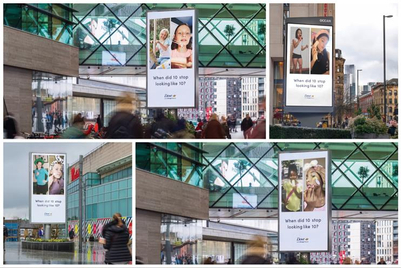
“I don’t call it a belly, I call it extra charm.” The quote lingers on screen as its speaker, Reli, confidently poses for the camera in a promotional documentary to launch lingerie brand Neiwai’s No Body is Nobody campaign. “I know I am not slim, but I feel it’s okay to be plus size. Beauty cannot be so easily defined. I really like how I look right now. The world has changed, being plus size is not a shame,” she tells the camera.
Centred around the theme of body diversity, the first instalment of the campaign for the Shanghai-founded brand’s Spring/Summer 2020 Nude collection features six 'real' women, each sharing personal stories of challenging their stereotyped beauty 'flaws'—flat chest, 'big breasts, no brains', scars, tanned skin and wrinkles.
Stemming from its goal to connect with consumers beyond a commercial level, Neiwai (内外)—which translates to 'Inside and Outside'—has been increasing efforts over the past few years to expand its product line to meet the diverse needs of different body types that make up today’s China. “We dive deep into the real needs of women [and] try to solve the problems they face that are often overlooked—that’s how we differentiate ourselves,” a Neiwai spokesperson tells Campaign Asia-Pacific. “No Body Is Nobody means every type of figure deserves recognition and respect [...] We hope to tear off the negative labels by offering a true representation of women in China and highlighting the unique beauty of each aesthetic.”
Cemented by fashion and makeup marketing, and relying on celebrities and KOLs who fit the look to endorse products, bai shou mei (white, thin and beautiful) has long been the hallmark of female beauty across the country. However, Neiwai’s campaign and brand ethos is symbolic of a larger cultural shift. “Diverse looks are definitely more noticeable in many beauty and fashion brands’ marketing efforts in China," says Lee Folland, director of research at luxury marketing agency Reuter Communications. "This speaks to an evolution in consumer attitudes and preferences."
Keeping it real
“While traditional aesthetic standards and big-name celebrities are still favoured by the majority, there are segments of the population who consider more ‘real’ and relatable endorsers for brands to be more credible,” Folland continues. “These consumers are looking to showcase their individuality through the brands and products they purchase and desire. As a consequence, the looks and endorsers brands use in their marketing are starting to reflect this.”
Tellingly, Neiwai’s “real women” campaign resonated with consumers for its human portrayal, creating organic discussion across Chinese social-media platforms WeChat and Weibo. One user commented “I really like the Neiwai models, they’re becoming more and more inclusive. It’s true there’s more than one standard of beauty, we are all beautiful.” Another user was inspired to share her own story concluding, “When you are brave enough to express yourself, you will find that there are not so many people who care about your little imperfections.”

Voices from the sidelines pushing for a more inclusive definition of beauty are also getting louder thanks to the ever-increasing prevalence of KOL marketing across social-media platforms. Outside mainstream media, “we’re seeing the emergence of groups of self-expressing individuals who are amplifying the voice of different communities […] they’re redefining the idea of beauty in the modern world,” explains Sega Cheng. The CEO and co-founder of iKala—an AI-driven marketing startup specialising in the influencer market—Cheng finds the concept of beauty is even transcending the physical. “If you take a closer look, beauty KOLs are often labelled with multiple tags such as ‘travel’, ‘gourmet’ and ‘parenting’. They represent an attitude to life. Their lifestyle, beliefs [and] experiences as a whole create a new concept of beauty, which goes beyond look and body figure.”
Although it remains a relatively niche market today, expanding definitions of beauty and divergence from the mainstream are something brands should be prepared to see more of over the coming decade. According to a recent whitepaper from media agency Wavemaker, Connecting with Future Consumers: Women in China 2030, individualism and a desire for self-expression are a key driving force for change in consumer habits amongst Chinese women—who, it explains, increasingly represent “major players and key drivers of consumption” in the future largest economy.
Following in the footsteps of millennials who paved the way for “a new model of femininity with their independent, confident-striving and outspoken style,” the report predicts that by 2030, Chinese women will increasingly turn away from outdated 'ideals'. More personal, diverse and holistic, beauty will be “a total result of a face that is tailored to express one’s individuality, health, fitness as well as balance of mind.” Brands who connect with this demographic, it adds, will be those who customise products and marketing strategies to help individuals champion their own “uniqueness”.
The backlash risk
Still, straying from long-entrenched ideals that appeal to the majority of consumers today isn’t without risk. Fast-fashion outlet Zara faced backlash and divided netizens in 2019 after a global Zara Beauty campaign featured Guangzhou-native model Jing Wen with her freckles un-airbrushed. Preferring clear, dewy skin, many accused the Spanish brand of “uglifying” Chinese people, while others congratulated them for highlighting Li’s “natural beauty”.

Although a handful of campaigns have encouraged consumers to embrace natural looks—including Japanese cosmetic brand SK-II’s 2018 #BareSkinProject, which asked women to upload pictures of their unmade-up faces to Weibo—Folland believes the trend has not yet been fully adopted by brands in China. “It is a key selling point for foundation products, but less so for other makeup products or for fashion […] For example, looking at the latest product campaigns on Weibo by both foreign and local beauty brands, like Fenty, Urban Decay, or Perfect Diary, you see that glitter is trending both for face and eye, rather than a natural look.” Overall, he finds today’s, “young Chinese consumer is still more interested in the latest global beauty and fashion trends than pursuing their own beauty ideals.”
While the movement might be gradual, interpretations of beauty are shifting and expanding in the Chinese market and brands should be listening. “Beauty standards are built on perceptions developed over a long period of time,” says Neiwai’s spokesperson. However, as social media offers more channels to champion alternative aesthetics, confident female consumers increasingly prioritise self-expression, and local brands tailor products for different body types, they believe a singular definition of beauty will fade and marketing campaigns will inevitably require a whole range of new looks.



.jpg&h=334&w=500&q=100&v=20250320&c=1)





+(900+x+600+px)+(3).png&h=334&w=500&q=100&v=20250320&c=1)
.jpg&h=334&w=500&q=100&v=20250320&c=1)





.png&h=268&w=401&q=100&v=20250320&c=1)
.jpg&h=268&w=401&q=100&v=20250320&c=1)
.png&h=268&w=401&q=100&v=20250320&c=1)
